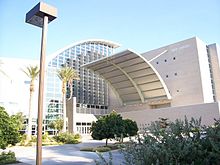Lied Library
This article contains wording that promotes the subject in a subjective manner without imparting real information. (February 2019) |

The Lied Library building, at 5 stories and 302,000 square feet (28,100 m2), is the largest on University of Nevada, Las Vegas's (UNLV) campus in Paradise, Nevada. The Architect of Record was Simpson Coulter Studio (formerly Welles Pugsley Architects). The University of Nevada, Las Vegas Libraries were established in 1957 and now include the main Lied Library (pronounced LEED), four branch libraries: Architecture Studies Library, Health Sciences Library, Teacher Development & Resources Library, and Music Library. In addition, one virtual campus is supported (Singapore Campus). The UNLV University Libraries offers a collection of more than one million volumes, access to over 20,000 online and print journals and more than 2 million additional resources of various media such as microfilm, DVDs, and government publications. The library is equipped with over 250 computers and is part of the campus wireless network. Visitors with identification may use library computers to access the University Libraries' online holdings, but Internet access is not available to the general public.[1]
Special features[]
The $55.3 million Lied Library first opened its doors on January 8, 2001. The University of Nevada, Las Vegas University Libraries was recognized for several technological innovations, including:
Lied Automated Storage and Retrieval[]
The Lied Automated Storage and Retrieval (LASR) unit in Lied Library integrates industrial automated materials handling technologies with the online library catalog system to provide an innovative solution to long-term library storage. Three computer-controlled cranes provide access to bins full of stored materials. Library patrons access stored materials through the library catalog. The LASR operator receives the electronic request and activates the appropriate crane to retrieve the materials. LASR is designed to store approximately 600,000 volumes and can be expanded to handle an additional 600,000 volumes. Currently items such as older bound periodicals, lesser-used government publications, and microforms are stored in LASR. [2]
Media Distribution System[]
The Media and Computer Services Department in Lied Library provides viewing and listening capabilities for the media collection via an integrated video network system (Safari). This system allows the delivery of analog and digital media to library carrels, preview rooms, multimedia PCs, library classrooms, and conference rooms. The media distribution system is currently equipped to play back VHS, DVDs, CDs, audio cassettes and selected cable channels, and to receive satellite downlinks. This system frees the user from having to move from machine to machine and from physically handling all the equipment and materials, and it links beyond Lied Library and connects with selected branch libraries, conference rooms, and campus classrooms.[3]
Digital ID[]
Lied Library, Teacher Development and Resource Library and the Architecture Studies Library have implemented a state-of-the-art collection management system using the 3M Digital Materials Flow Management system. The system uses radio frequency identification (RFID), allowing staff to track, identify, and control library material more efficiently. The Digital ID technology is used in the Libraries' self-checkout stations and in the staff workstations to handle borrowing transactions. A hand held scanner is used by staff to rapidly check shelf order, to search for missing items, to perform inventories, and to record in-house use of most items. The Architecture Studies Library incorporated the same system during the summer of 2006. [4]
External links[]
- UNLV Libraries webpage
- UNLV Teacher Development & Resources Library
- UNLV Special Collections
- UNLV Architecture Studies Library
- UNLV Music Library
- UNLV Health Sciences Library
- UNLV Digital Collections
- UNLV Libraries - A Brief History
- Lied Library Construction Photo Archive
- Lied Library Mission and Vision Statement
Notes[]
References[]
- Starkweather, Wendy. University Libraries Fact Sheet. University of Nevada, Las Vegas, University Libraries. Last updated: Sept 7, 2005. Accessed: June 4, 2007.
- Chung, Su Kim. UNLV Libraries - A Brief History Accessed: June 4, 2007.
| Wikimedia Commons has media related to Lied Library. |
Coordinates: 36°06′25″N 115°08′33″W / 36.1070°N 115.1425°W
- 2001 establishments in Nevada
- Buildings and structures in Paradise, Nevada
- Libraries in Nevada
- Library buildings completed in 2001
- University and college academic libraries in the United States
- University of Nevada, Las Vegas
